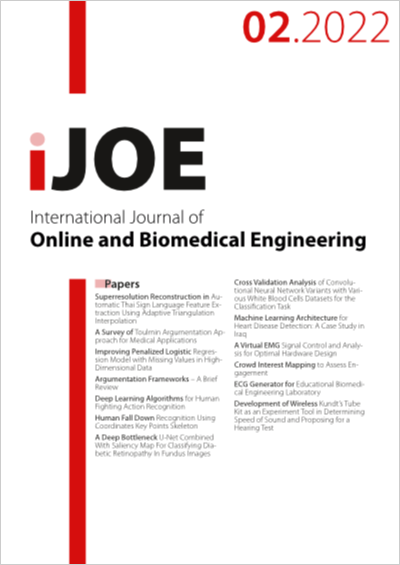Deep Learning Algorithms for Human Fighting Action Recognition
DOI:
https://doi.org/10.3991/ijoe.v18i02.28019Keywords:
VGG-16, human action recognition, YOLOv3, deep learning, OpenPoseAbstract
— Human action recognition using skeletons has been employed in various applications, including healthcare robots, human-computer interaction, and surveillance systems. Recently, deep learning systems have been used in various applications, such as object classification. In contrast to conventional techniques, one of the most prominent convolutional neural network deep learning algorithms extracts image features from its operations. Machine learning in computer vision applications faces many challenges, including human action recognition in real time. Despite significant improvements, videos are typically shot with at least 24 frames per second, meaning that the fastest classification technologies take time. Object detection algorithms must correctly identify and locate essential items, but they must also be speedy at prediction time to meet the real-time requirements of video processing. The fundamental goal of this research paper is to recognize the real-time state of human fighting to provide security in organizations by discovering and identifying problems through video surveillance. First, the images in the videos are investigated to locate human fight scenes using the YOLOv3 algorithm, which has been updated in this work. Our improvements to the YOLOv3 algorithm allowed us to accelerate the exploration of a group of humans in the images. The center locator feature in this algorithm was adopted as an essential indicator for measuring the safety distance between two persons. If it is less than a specific value specified in the code, they are tracked. Then, a deep sorting algorithm is used to track people. This framework is filtered to process and classify whether these two people continue to exceed the programmatically defined minimum safety distance. Finally, the content of the filter frame is categorized as combat scenes using the OpenPose technology and a trained VGG-16 algorithm, which classifies the situation as walking, hugging, or fighting. A dataset was created to train these algorithms in the three categories of walking, hugging, and fighting. The proposed methodology proved successful, exhibiting a classification accuracy for walking, hugging, and fighting of 95.0%, 87.4%, and 90.1%, respectively.
Downloads
Published
How to Cite
Issue
Section
License
Copyright (c) 2022 Mohammed Abduljabbar Ali, Abir Jaafar Hussain, Ahmed T. Sadiq

This work is licensed under a Creative Commons Attribution 4.0 International License.


